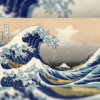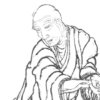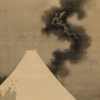Hishida Shunsō
| NAME | Hishida Shunsō / 菱田春草 |
| BIRTH & DEATH | 1874-1911 |
| BIRTHPLACE | Nagano pref. |
| PEN NAME | 晴天, 秋江, 春草, 黄壑, 長照 |
| MASTER | Yūki Masaaki, Hashimoto Gahō, Okakura Tenshin, Kawabata Gyokushō |
| POSITION |
|
| RECORD OF AWARDS |
, etc |
| NOTE |
DESCRIPTION
Hishida Shunsō (菱田春草, 1874-1911) was a Japanese-style painter. Born in Nagano prefecture; lived in Tokyo. A frequent prize winner.
In 1895 graduated from Tokyo School of Fine Arts, where Okakura Tenshin served as director and where he studied under Hashimoto Gahō. In 1896 appointed instructor at his alma mater; in 1898 resigned to found, with Okakura Tenshin and some of his classmates, the Nihon Bijutsuin. Study trip to India in 1903; to USA, England, and France in 1904. In spite of his early death, holds an important position in the development of modern Japanese-style painting. Member of the Nihon Bijutsuin. With his friend Yokoyama Taikan, experimented with technique known as “Mōrōtai” (the so-called dimness style). In his painting, discarded use of outline, relying in the Western manner on color and chiaroscuro for modeling; his style, within Japanese limits, quite realistic. His kachoga (bird-and-flower painting) have considerable quality. His early work romantic, sometimes sentimental; his later work slightly realistic, and, finally, almost mystic.
In 1909, his work Ochiba won the highest award at the 3rd Bunten Exhibition. It is now designated an Important Cultural Property by the Japanese government’s Agency for Cultural Affairs and is now in the collection of the Eisei Bunko Museum, Tokyo. His work Black Cat (1910) has also been designated an Important Cultural Property.
« Back to Index








